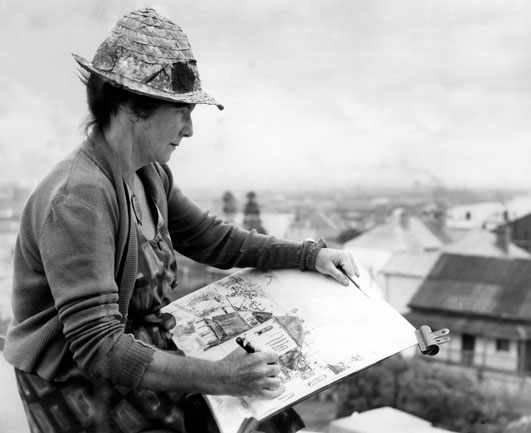There are a number of phone calls that I dread, although they are inevitable. One arrived last Wednesday when the SMH Arts Editor, Clare Morgan, rang to tell me that Margaret Olley had died. Margaret has been a fixture on the Australian art scene since the 1940s, and it would be difficult to think of anyone who has been a more generous benefactor to Australian museums, or a better friend to young artists.
First and foremost, Margaret was a painter: a creator of still lifes and occasional landscapes that sold as fast as she could finish them. In the past few days there has been a lot of hyperbole surrounding these pictures, but one need not exaggerate Margaret’s talents in order to appreciate her dedicated and modest attitude. She made no claims for her own genius, being content to work in the same genre as artists such as Chardin, Bonnard, Matisse and Picasso. ‘Good enough for them, good enough for me’ was her motto.
What will be especially missed is Margaret’s forthright approach, which is so rare in the art world. She never hesitated to give an opinion, never worried about offending the febrile sensibilities of curators, collectors or would-be connoisseurs. She was an artist and a human being of irreproachable integrity.
It would have been good to hear her views on the sharp turn towards the contemporary being taken by the Art Gallery of NSW, to which she was a major benefactor. Many artists owe their representation in that collection to Margaret’s donations, and she would not permit her money to be spent on works she did not consider worthwhile. It’s an example that other potential donors would be wise to follow, as there is a real danger of money being squandered on high-priced, modish ephemera at the expense of other parts of the collection.
I’d like to think I’m just being alarmist, but it’s far too easy to get excited about aspects of contemporary art that seem laughable in hindsight. Margaret always trusted her own eye when judging a work, and that’s a lesson for all time.
Goodbye Margaret Olley, you shall be missed.
Up in Brisbane last week, it seemed as though the city had never been touched by the disastrous floods that struck at the beginning of the year. Everything is back to its normal state of burgeoning optimism. It’s almost a state of innocence compared with cities such as Sydney and Melbourne. The ridiculous claims made recently in the press that Brisbane is on the verge of being Australia’s “culture capital” are unsustainable, largely because of a lack of population. This is not the fault of the Queensland Art Gallery, which is doing everything it can to attract audiences and make children feel that the gallery is a desirable place to be, not simply the venue for a school excursion. What we are seeing in Brisbane is the rapid transition from a provincial capital, an old-time frontier town, to a sophisticated modern metropolis. The exhilaration of this transition is infectious.
As well as the big Surrealism show from the Centre Pompidou, at the Gallery of Modern Art, I had time to visit Philip Bacon and see the most recent exhibition by William Robinson, who has strong claims to being the most accomplished painter in Australia today. No-one could be more methodical, more reserved, in both life and art, but Robinson’s paintings speak for themselves. The new landscapes are full of subtleties, and perhaps a few liberties in terms of the freedom with which he has wielded the brush. Downstairs it was all still life – an unusual but impressive performance, almost as if he simply wanted to show us he could be master of another genre.

Around the corner at Jan Murphy’s gallery, Danie Mellor had a show that was almost as meticulous as Robinson’s in its craftsmanship. Yet Mellor has a political point to make, in pictures that combine tourist kitsch with the blue-and-white imagery of Delft china. Yes, it’s all about the evils of colonialism, but done with a brand of good humour that is rare in this sort of work. It’s hard to be too serious about a picture such as A Stroll through Antiquity, with its native fauna and Aborginal family placed among the austere monuments of the Neo-Classical era. It seems that one need not go to GoMA to find Surrealism in Brisbane.


